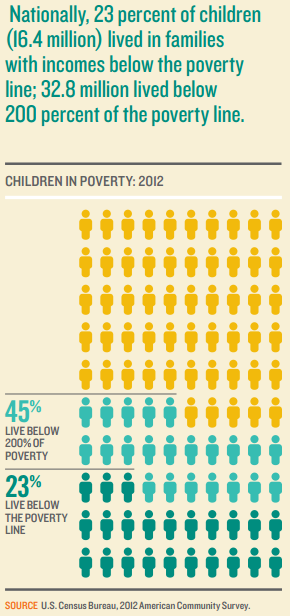Children’s Well-Being Reflects a Sluggish Economic Recovery
Blog Post

July 24, 2014
Earlier this week the Annie E. Casey Foundation released the 25th annual KIDS COUNT Data Book
http://www.aecf.org/resources/the-2014-kids-count-data-book/"
, which measures child well-being, from infancy through the teen years, in four areas: education, health, economic well-being, and family and community. The researchers found that on the whole, children today appear better off in terms of education and health than children five or even 25 years ago. Trends for economic well-being and family and community were not as encouraging, perhaps because families and states are still recovering from The Great Recession.
Over half of the KIDS COUNT indicators showed improvement in recent years, but this doesn't necessarily translate to changes in welfare for America’s most at-risk children. Large disparities exist between kids of different races, income levels, and locations. So while children overall may be doing better today than their predecessors, far too many children still aren't receiving the resources they need to succeed. The Data Book ranks states, and judging by this map, children in the southern half of the United States are not faring especially well. While all states continue to feel the effects of the recession, some have been more successful overcoming these challenges to address child well-being than others.
The authors write that, “In the area of education, the years since 1990 have brought steady, incremental success,” which may be true, but paints a very optimistic picture of progress. KIDS COUNT uses four indicators to measure education: pre-K attendance, 4th grade reading proficiency, 8th grade math proficiency, and high school graduation rates. While these four metrics are valuable, they offer limited insight into how well our education system is serving children. And while all four measures did improve since 2005, progress was limited.
Pre-K enrollment increased an impressive 34% over the last 25 years, but it only increased by two percentage points from 2005 to 2012. And access varies significantly among states—children in New Jersey are twice as likely to be enrolled as those in Nevada, with enrollment hovering around 62% and 30% respectively. Despite initiatives to expand access to early education at the federal, state, and local levels, and an unprecedented amount of public support for investment in this area, 54% percent (more than half!) of the nation’s 3- and 4-year-olds are still not enrolled in pre-k. The authors explain that state efforts to expand pre-K access were largely hindered by the recession.
This past January, my colleagues at New America came to a similar conclusion in Subprime Learning: Early Education in America Since the Great Recession. This report outlines how early education has fared during and after the economic downtown. And after analyzing numerous indicators, they concluded that the lack of progress in early education policy goes beyond just pre-K enrollment. Instead, “learning opportunities essentially stagnated for children from birth up through third grade.”

These findings are especially worrisome considering that six of the eight KIDS COUNT indicators for economic and family well-being have yet to return to pre-recession levels. The official child poverty rate has increased to 23%, meaning about one in four children live in families that are scraping to get by. And more than one-third of children now live in single-parent families, a demographic particularly vulnerable to landing in poverty. With economic inequality worsening, and more children living in deep poverty, it is crucial that low-income children have access to programs like pre-K that can help support their well-being and long-term academic success.
The Data Book breaks down the education data by race and state, but not by income level, making it difficult to determine whether the most at-risk children are improving. While not highlighted in the 2014 report, more specific education data is available at the KIDS COUNT Data Center—a useful resource that breaks down the indicators by factors like income, English language learner status, and disability status. It’s important to take family income into account when measuring education progress. While the achievement gap between African American and white students has narrowed in recent years, it has considerably widened in terms of income.
While overall improvements in pre-K access, test scores, and graduation rates across the population are promising, progress has been too slow. This is especially damaging for the most disadvantaged children who can suffer life-long consequences from exposure to toxic stress. As the report explains, the “well-being of our country’s children is the most important indicator of our long-term economic and social future.” The data suggest that, similar to the country’s housing market and unemployment rates, children’s well-being has been slow to recover from the recession.